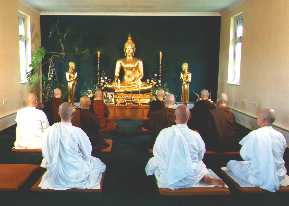
|

On August 1st 1984 two monks arrived at Amaravati from
Chithurst to unlock the gates and open the
site. A more striking entrance was made the next day by the entire group of nuns who had
walked on pilgrimage from Chithurst carrying the relics that were later to be enshrined in
the white stupa in the field.
For historical reasons, the original training for nuns has fallen into abeyance in the
Theravada form of Buddhism that the Amaravati Sangha practises. The opportunities and
standards of training for nuns in Theravada countries is often secondary and inferior to
that of the monks.
Such a state of affairs seemed inappropriate to
import into Britain, but changing religious traditions is also a sensitive issue. In the
early years women were given the eight precepts, but it became clear that this didn't
provide enough support for living in a communal monastic situation, so a higher ordination
was requested and the nuns training began to evolve. |


The nuns community meditating in the Bodhinyana Hall
before the Buddha rupa which was
originally enshrined in the old school assembly hall.
|
Initial guidance came from the
Bhikkhu Sangha and then, after some years, the leadership of the nuns' community and the
evolution of their training was given to the elder nuns to oversee. Since the 1980s the
nuns have been called 'siladhara' (those who uphold virtue) and in accordance with their
level of experience they occupy a position in the monastic establishment equivalent to
that of the bhikkhus. |